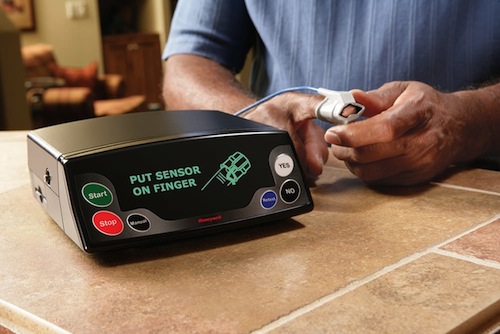Rita, who is 79 years old, has congestive heart failure, a chronic health condition that lands many people in the hospital or nursing home. Telemedicine has allowed her to closely monitor important vital signs and stay in her own home.
According to the CDC, approximately 5.1 million people in the United States have congestive heart failure. Close to 1 million are hospitalized every year and 27 percent are readmitted within 30 days — the highest readmission rate of all medical conditions.
Congestive heart failure and its symptoms
Congestive heart failure develops when the heart can’t pump enough blood to the rest of the body. Symptoms include:
- Cough
- Fatigue, weakness, faintness
- Loss of appetite
- Need to urinate at night
- Pulse that feels fast or irregular, or a sensation of feeling the heart beat (palpitations)
- Shortness of breath when you are active or after you lie down
- Swollen (enlarged) liver or abdomen
- Swollen feet and ankles
- Waking up from sleep after a couple of hours due to shortness of breath
- Weight gain
After spending time in the hospital followed by a stay in a rehab facility, Rita returned to her home the end of January. She’s been able to stay there thanks to family, friends and home health care. She also relies on telemedicine (telehealth) to help monitor her congestive heart failure.
Something as routine as getting on the scale every day can be helpful in monitoring for early signs of congestive heart failure. Gaining just a few pounds could mean fluid is building up inside the body. It’s also important to keep track of blood pressure and oxygen levels.
Telemedicine
Androscoggin Home Care and Hospice in Lewiston provided Rita with a monitor, a scale, a blood pressure cuff and an oxygen meter that fits on the end of her finger. The monitor comes on at the same time every morning. “It tells me to stand on the scale,” Rita explains, “and then it gets your weight. Then I put the sleeve on my arm and it takes my blood pressure and the O2 meter on my finger.”
The data is transmitted to Rita’s nurse at Androscoggin Home Care. The monitor, which looks somewhat like an alarm clock, can plug into a phone jack or connect to a cell phone or special tablet provided by the agency. “Our registered nurses are seeing their patients’ vital signs every day,” says telehealth coordinator Shane Levasseur. “In addition, we can see vital sign trends. We could, for example, send a two week trend of vital signs over to a patient’s cardiologist for an upcoming appointment. It’s really powerful for doctor to have that information. Now a lot of physicians who send referrals for home care say they want telehealth.”
More and more home care agencies and hospitals in Maine and around the country are turning to telemedicine for patients. Levasseur says just three years ago Androscoggin had 25 monitors and only four were in use. Today it has nearly 250. Nearly all are being used and more will be purchased this year.
Putting in-home technologies to better use for the elderly
Earlier this year, the Governor’s Broadband Capacity Building Task Force issued a report outlining eight recommendations — number two was to help Maine’s elderly stay at home by better utilizing telemedicine.
“Use in-home technologies to reduce the proportion of elderly on MaineCare receiving long-term care in institutions from 65% to 40% by 2015, and to 20% by 2020. This will allow seniors to stay home longer — which is what they want — and at the same time save Maine taxpayers over $100 million in 2015, and over $250 million annually in 2020.”
Rita admits that, left to her own devices, she might not alert anyone right away if she noticed telltale signs of congestive heart failure. Her home care nurse doesn’t rely only on the monitor — she visits once a week — but if she notices something amiss, she’ll contact Rita immediately. “If I’m two pounds different from yesterday,” says Rita, “wow! Right way, the nurse wants to know if there’s a reason for that. Am I swelling? That’s a first sign of heart failure.”
On one occasion, the nurse decided she needed a trip to the emergency room. If Rita had waited, she might have been in big trouble. “I don’t really know sometimes if I need to go, but the nurse knew based on what the monitor said. She came to the house and said, ‘You’re going!”‘
Utilizing monitors like the one that allows Rita to stay home is only one example of new technologies that are already being used in Maine. You can read about some others as well as the remaining broadband use recommendations (not all health-related) in the full task force report or an eight-page version.



Leave A Comment